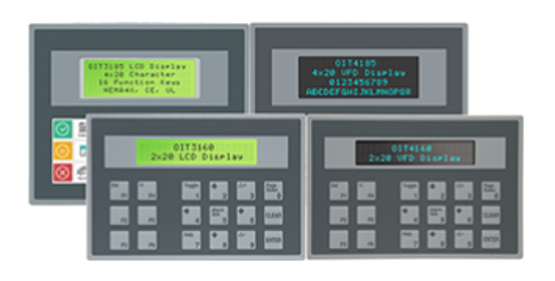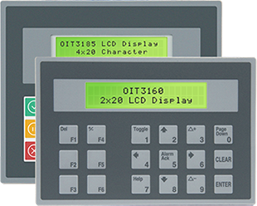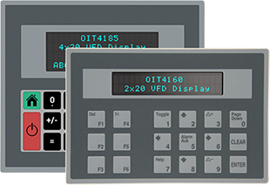Your cart is currently empty!

Micro OIT, Extended Temperature, Class I, Division 2
OIT5400B
This product is obsolete and there is no direct replacement. See our Standard, Advanced, or High Performance HMIs for upgrade options, or check out our OIT product for similar looks and function.
Review this product
Share your thoughts with other customers about this product
This product is obsolete and there is no direct replacement. See our Standard, Advanced, or High Performance HMIs for upgrade options, or check out our OIT product for similar looks and function.
What is OITware?
Maple Systems OITware-200 comes with powerful features to make configuring your OIT products more intuitive:- Multi-language support allows you to configure an OIT with 2, 5, or 10 different languages
- Recipe uploads and downloads can be triggered by either the OIT or the controller
- Remote variable storage function provides greater storage capacity
- Your Operator Interface Terminal, or OIT, can be configured as a Modbus slave device
- Expanded support for Allen-Bradley MicroLogix Controllers, including the L data file
- Added support for CTC motion controllers, Yaskawa-Magnetek controllers, and Control Microsystems controllers
What is an Operator Interface Terminal ( OIT )?
Maple Systems Alphanumeric OITs are powerful, affordable operator interface terminals. Our units offer best-in-class features including:- 2 and 4-line LCD and VFD Displays
- 16 and 24-key keypads
- unique user-definable keypads
- slide-in legends.

What is the difference between VFD and LCD OITs?
Great for normal lighting conditions, our Backlit LCD (Liquid Crystal Display) Operator Interface Terminals, or OITs, are rugged and reliable. They are operable in temperature extremes ranging from -10°C up to 65°C. Features include 2 or 4-line Displays, 6 to 24-key keypads, a custom slide-in legends and are Class I, Division 2. VFD (Vacuum Fluorescent Displays) Operator Interface Terminals, or OITs, are useful in situations where a crisp high-contrast display is desired. The light-emitting display makes it more readily viewable in low-light environments. They are operable in temperature extremes ranging from -10°C up to 65°C. Features include 2 or 4-line Displays, 6 to 24-key keypads, a custom slide-in legends, and are Class I, Division 2.
VFD (Vacuum Fluorescent Displays) Operator Interface Terminals, or OITs, are useful in situations where a crisp high-contrast display is desired. The light-emitting display makes it more readily viewable in low-light environments. They are operable in temperature extremes ranging from -10°C up to 65°C. Features include 2 or 4-line Displays, 6 to 24-key keypads, a custom slide-in legends, and are Class I, Division 2.

What is the difference between Human Machine Interface (HMI), and Operator Interface Terminal (OIT)?
All OITs are HMIs, but not all HMIs are OITs. OIT usually means a dedicated terminal with graphics and/or text that provides data/control of a local (rather than remote) piece of equipment or a process by a person acting as an operator of said equipment. HMIs can also mean the same thing, but they can also be something that provides remote monitoring and/or operational control of an entire system.
What is HMI?
What is an HMI or Human Machine Interface?
A Human-Machine Interface (HMI) is a user interface that facilitates communication between a person and a machine, or system. While this can technically refer to any screen that enables user interaction with a device, it is most commonly associated with industrial processes.
Although “HMI” is the most widely used term, this technology is also known by other names, including Man-Machine Interface (MMI), Operator Interface Terminal (OIT), Local Operator Interface (LOI), and Operator Terminal (OT). It’s important to note that while HMI and Graphical User Interface (GUI) are similar, they are not synonymous. GUIs are often components within HMIs, particularly for enhancing visualization capabilities.
In industrial environments, HMIs serve several functions, such as:
- Control and operation of a system’s functions
- Overseeing machine inputs and outputs
- Tracking production times, trends, and tags
- Visually displaying data
- Monitoring key performance indicators (KPIs)
- And more
HMIs are available in various formats, ranging from built-in screens on machinery to computer monitors and tablets. Regardless of their form or the specific terminology used, the primary purpose of an HMI is to provide insights into the performance and status of mechanical systems.
Software Downloads & Upgrades
Manuals & Guides
Articles
-
 9.7″ High Performance HMI$1,050.00
9.7″ High Performance HMI$1,050.00 -
 10.1″ Low-Cost HMI$660.00
10.1″ Low-Cost HMI$660.00 -
 2 x 20 VFD, Keypad HMI$570.00
2 x 20 VFD, Keypad HMI$570.00 -
 2 x 20 VFD, Keypad HMI$570.00
2 x 20 VFD, Keypad HMI$570.00 -
 4 x 20 VFD, Keypad HMI$655.00
4 x 20 VFD, Keypad HMI$655.00
-
 Cable, Configuration, RJ45/232/9S, 5′$65.00
Cable, Configuration, RJ45/232/9S, 5′$65.00 -
 Cable, CAT5E Ethernet, Crossover, 5′$15.00
Cable, CAT5E Ethernet, Crossover, 5′$15.00 -
 EasyAccess 2.0 Activation Card. Remote Access$99.00
EasyAccess 2.0 Activation Card. Remote Access$99.00
